
Columbus is a city in and the county seat of Bartholomew County, Indiana, United States. The population was 50,474 at the 2020 census. The relatively small city has provided a unique place for noted Modern architecture and public art, commissioning numerous works since the mid-20th century; the annual program Exhibit Columbus celebrates this legacy. Located about 40 mi (64 km) south of Indianapolis, on the east fork of the White River, it is the state's 20th-largest city. It is the principal city of the Columbus, Indiana metropolitan statistical area, which encompasses all of Bartholomew County. Columbus is the birthplace of former Indiana Governor and former Vice President of the United States, Mike Pence.
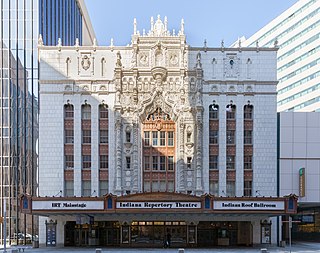
The Indiana Theatre is a multiple use performing arts venue located at 140 W. Washington Street in Indianapolis, Indiana. It was built as a movie palace and ballroom in 1927 and today is the home of the Indiana Repertory Theatre. It was added to the U.S. National Register of Historic Places in 1979. It is located in the Washington Street-Monument Circle Historic District.
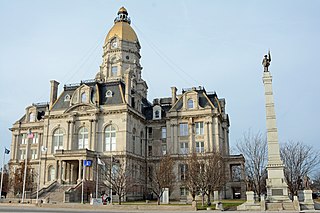
The Vigo County Courthouse is a courthouse in Terre Haute, Indiana. The seat of government for Vigo County, the courthouse was placed on the National Register of Historic Places in 1983.

The Republic is an American daily newspaper published in Columbus, Indiana, United States. It is owned by AIM Media Indiana, a subsidiary of AIM Media.

Hope Historic District is a 114-acre (46 ha) national historic district located at Hope, Bartholomew County, Indiana. It encompasses 205 contributing buildings, four contributing sites and two contributing objects in the central business district and surrounding residential areas of Hope. It was developed between about 1840 and 1940, includes works by architect Elmer E. Dunlap and by L.W. Weisner, and notable examples of Greek Revival, Italianate, Hall and parlor, and other architecture. Notable buildings include the Moravian Church (1875) and old parsonage (1875), City School (1906), Baptist Church, Methodist Episcopal Church (1887), Alfred Sanford Rominger House, Frank Stapp House, Masonic Temple (1910), and E.B. Spaugh Building (1915).
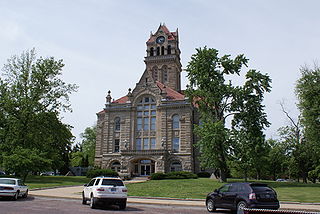
Caldwell & Drake was a construction firm based in Indiana, USA. It included George W. Caldwell and Lester Drake.

Cannelton Historic District is a national historic district located at Cannelton, Perry County, Indiana. The district encompasses 178 contributing buildings, 42 contributing structures, and 2 contributing objects in the central business district and surrounding residential and industrial areas of Cannelton. The area developed between 1837 and 1936, and includes notable examples of Gothic Revival, Late Victorian, and Bungalow / American Craftsman style architecture. A number of the buildings are constructed of native sandstone. Notable buildings include the National Historic Landmark Indiana Cotton Mill (1849-1850), St. Michael's Church (1859), F. H. Clemens Store, Cannelton Sewer Pipe Company, Josie Nicolay House, Myers Grade School / The Free School (1868), Jacob Heck Building (1882), Perry County Courthouse (1896-1897), and the separately listed St. Luke's Episcopal Church.

Bartholomew County Courthouse is a historic courthouse located at Columbus, Bartholomew County, Indiana. It was designed by noted Indiana architect Isaac Hodgson, built in 1871–1874 at the cost of $250,000, and dedicated in 1874. Construction was by McCormack and Sweeny. The building was hailed as "the finest in the West" upon its completion.

Columbus City Hall is a historic city hall located at 5th Street and Franklin Street in Columbus, Indiana, United States. It was designed by architect Charles Franklin Sparrell and built in 1895. It is a three-story, Romanesque Revival style red brick building on a limestone foundation. It features a steeply pitched slate roof, prominent parapet gables, and four-story tower above an arched entrance.
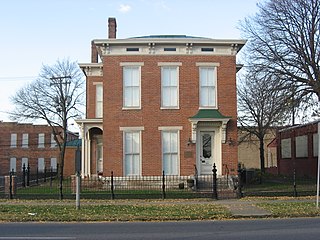
McEwen-Samuels-Marr House is a historic home located at Columbus, Indiana. The rear section was built in 1864, and the front section in 1875. It is a two-story, Italianate style brick dwelling. It has a stone foundation, four brick chimneys, and a hipped roof. The building has housed the Bartholomew County Historical Museum since the 1970s.

New Hope Bridge, also known as Bartholomew County Bridge No. 133, is a historic Pratt through truss bridge spanning the Flatrock River at Columbus Township, Bartholomew County, Indiana. It was designed by the Caldwell & Drake ironworks and built in 1913. It consists of two spans, with each measuring 128 feet long. It rests on concrete abutments and a concrete pier.

Washington Commercial Historic District is a national historic district located at Washington, Daviess County, Indiana. The district encompasses 88 contributing buildings and 1 contributing object in the central business district of Washington. The district was developed roughly between 1815 and 1940, and includes notable examples of Italianate, Federal, and Classical Revival style architecture. Located in the district is the separately listed Daviess County Courthouse. Other notable buildings include the City Hall (1916), Temple Court (1894), Peoples National Bank (1928), Masonic Building, Indiana Theater, American Steam Laundry Building, Baltimore and Ohio Passenger Depot (1906), Westminster Presbyterian Church (1911), and U.S. Post Office (1916).

The New Castle Commercial Historic District is a national historic district located at New Castle, Henry County, Indiana. It encompasses 64 contributing buildings in the central business district of New Castle. It developed between about the 1849 and 1941, and includes many excellent examples of Italianate, Classical Revival, and Commercial styles of architecture. Notable sites of interest include the separately listed Henry County Courthouse. Other notable buildings include the L.A. Jennings Building (1877), Odd Fellows Hall, Murphey Building, Knights of Pythias Building (1891), Masonic Temple (1892), Bradway Building (1902), former United Brethren Church, Citizens State Bank Building (1923), S.P. Jennings and Sons Handle Factory complex, and Coca-Cola Bottling Building.
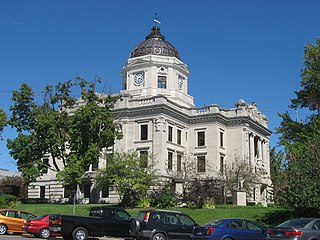
Courthouse Square Historic District is a national historic district located at Bloomington, Monroe County, Indiana. The district encompasses 57 contributing buildings in the central business district of Bloomington. It developed between about 1847 and 1936, and includes notable examples of Classical Revival, Beaux Arts and Italianate style architecture. Located in the district are the separately listed Bloomington City Hall, Monroe County Courthouse, Princess Theatre, and Wicks Building. Other notable buildings include the Federal Building, Masonic Temple, former Faulkner Hotel, Odd Fellows Building (1892), Allen Building (1907), First National Bank Building (1907), Knights of Pythias Building (1907), and Graham Hotel Building.

Rockville Historic District is a national historic district located at Rockville, Parke County, Indiana. The district encompasses 210 contributing buildings, 3 contributing structures, and 1 contributing object in the central business district and surrounding residential sections of Rockville. It developed between about 1826 and 1942, and includes notable examples of Italianate, Colonial Revival, and Queen Anne style architecture. Notable contributing resources include the Parke County Courthouse (1882), Memorial Presbyterian Church (1891), Sheriff' Residence and Jail, U.S. Post Office (1938), Rockville Public Library (1916), Methodist Episcopal Church, Rockville Grade School (1941), Parke County Seminary (1839), Rockville Opera House (1912), First National Bank (1907), Judge Samuel Maxwell House, Dr. P.Q. Stryker House (1838), Dr. Harrison J. Rice House (1880), and Dr. Marion Goss House (1907).

Rushville Commercial Historic District is a national historic district located at Rushville, Rush County, Indiana. The district encompasses 54 contributing buildings in the central business district of Rushville. The district developed between about 1847 and 1940 and includes notable examples of Greek Revival, Italianate, Romanesque Revival, Classical Revival, Collegiate Gothic, Commercial style, and Art Deco style architecture. Located in the district are the separately listed Durbin Hotel, Melodeon Hall, and Rush County Courthouse. Other notable buildings include the former Methodist Episcopal Church (1847-1850), Church of Christ / Boys' and Girls' Club (1850-1853), Beher-King Block (1883), Presbyterian Church (1892-1893), Rushville National Bank (1911), Phoenix Lodge (1913–1915), Rushville Public Library, and former Castle Theatre (1939).

West Washington Historic District is a national historic district located at South Bend, St. Joseph County, Indiana. It encompasses 330 contributing buildings in an upper class residential section of South Bend. It developed between about 1854 and 1910, and includes notable examples of Italianate, Greek Revival, and Romanesque Revival style architecture. Located in the district are the separately listed Morey-Lampert House, Oliver Mansion designed by Lamb and Rich, Second St. Joseph County Courthouse, South Bend Remedy Company Building, and Tippecanoe Place. Other notable buildings include the Bartlett House (1850), Birdsell House (1897), DeRhodes House designed by Frank Lloyd Wright, Holley House, Kaiser-Schmidt House, Listenberger-Nemeth House, Meahger-Daughterty House (1884), O'Brien House, Oren House, The People's Church (1889), St. Hedwig's Church, St. Patrick's Church (1886), St. Paul's Memorial United Methodist Church (1901), West House, and a row of worker's houses.

Pierson–Griffiths House, also known as the Kemper House, is a historic home located at Indianapolis, Indiana. It was built in 1873, and is a 1+1⁄2-story, rectangular, five bay frame dwelling on a low brick foundation. It has elements of Greek Revival and Second Empire style architecture. It features a full-width front porch with grouped columns and a low hipped roof with decorative cut wood cresting around the perimeter.
The Frederick Youngman House was a historic home located in Kokomo, Indiana. It was built in 1876, and was a two-story, Italianate style brick dwelling. It featured a wide, bracketed wood cornice. It was destroyed by fire after being struck by lightning in June 1992.































